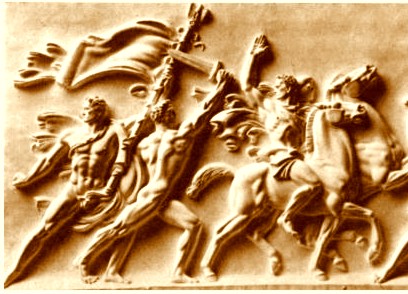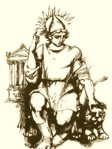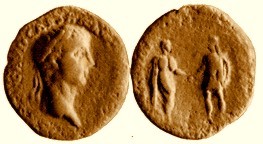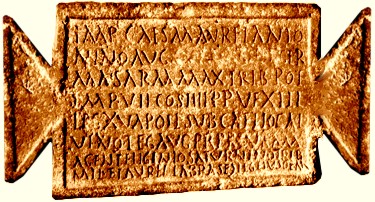![]()
![]()
PRINCE TIRIDATES IN
THE ROMAN COURT

Written by Gevork Nazaryan
King Trdat III was born in the year 250. He was the firstborn son of the reigning King Xosrov who for nearly three decades [from 226 to 252] fought the Persian Sassanians in order to see the restoration of the Arsacids in Iran. The Sassanians had a hostile stance toward all of the members of the Aršakuni Royal House, which by the Sassanians was viewed as a treat to the Persian Kingdom [the Aršakuni Parthian Royal House ruled Iran for nearly 500 years and was overthrown in Iran in the year 226 by the Sassanians]. Persian Shah, Šapur Sassanian, fearful of ever-growing resentment of Xosrov and his plan of restoration of the rightful heirs of Iran, the Arsacids, in 252 organized a secret plot of assassination of King Xosrov Aršakuni. According to historian Agat'angełos' account, Anak Pahlavi [Parthian], the father of St. Gregory who would later become the first Catholicos, was accused of taking part in the successful assassination plot of the King . In the wake of assassination and confusion that followed, the young Prince Trdat, was quickly

THE ARMENIAN ROYAL MITHRAIC 8-SPOKE SOLAR TIARA [CORONA]
ALONG WITH BOW AND ARROW OF THE HUNTER-ARCHER [ORION-SAGITTARIUS]
ON ROMAN COINS. CONNOTING THE CLOSE ARMENO-ROMAN
ALLIANCE IN SOCIO-ECONOMIC, CULTURAL-SPIRITUAL
AND POLITICAL SPHERES, DURING THIS PERIOD.

SOLAR LIONS ON TOP OF PILLAR [PHALLIC] COLUMNS FLANKING THE
SACRED
MITHRAIC STELLA [MITHRAS BLESSING THE ARMENIAN KING] IN FRONT OF THE
HOLY MOUNTAIN -- OR[I]ONTID PANTHEON OF ARMANI ROYALTY.

VIRTVS MILITARIS.
HONOR AND GLORY OF THE MITHRAIC WARRIOR ARISTOCRACY.
smuggled out of the country by Artavazd Mandakuni, member of the royal court and a confidant of the late King Xosrov, to the safety of allied Rome. In the court of the Roman Empire, Trdat was beloved by his benefactor and personal friend the Emperor Licinius. In the Royal court Trdat learned the ways of Royal etiquette and code of behavior as a future royal monarch to be. As Trdat grew into adulthood his immense, almost superhuman strength became ever evident. As Edward Gibbon, the renowned British historian wrote in his monumental magnum opus "He [Trdat] signalised his youth by deeds of valour and displayed matchless dexterity, as well as strength in every martial exercise" [see The Decline and Fall of the Roman Empire, London, 1862].

ARMENIAN MITHRAISM WAS CARRIED OVER BY
MEMBERS OF THE ARMENIAN ARISTOCRACY TO ROME AND BEYOND
COMING HOME TO MOTHER ARMENIA THROUGH THE SNOW-COVERED GORGES
AND PASSES. FIRST ARMENIAN MILITARY MARK ALREADY VISIBLE TO THE KING
AND HIS EXPEDITION RETURNING FROM A LONG JOURNEY AFTER A PLEASANT
STAY IN THE COURT OF HIS CONFIDANT.
A description of Trdat III was given by the Father of Armenian History, the Vth century historian Mowsēs Xorenac‛i, who noted that "Trdat was physically so powerful that he could seize two wild bulls by the horns and break the horns with his bare hands". Another account of Trdat by Xorēnac‛i tells us how in a chariot race, the Prince leapt off his chariot and stopped the charging horses and the chariot of his rival. Yet another account told by Roman historians tells us how Prince Trdat, single handedly held back a group of

DENARIVS OF GAIVS CALIGVLA [ARA PONTIFEX...ARMAN
MITHRAIC HIGH PRIEST OF SOL INVICTVS...THE INVINCIBLE SUN
SHAKES HANDS WITH HIS ARMENIAN BROTHER]
GERMANICVS SHAKES HANDS [MUTUAL SUPPORT AND FRIENDSHIP]
WITH FELLOW MITHRAIC BROTHER ARMAN KING ARTAXIAS [ARTASHES II, 30-20 BC].
THE ARMENO-ROMAN LLIANCE EXTENDED WELL INTO THE ERA OF KING
TRDAT [TIRIDATES] III.

INSCRIPTION FROM VAŁARŠAPAT
MADE BY COMMODVS IN 185 AD
CONNOTING THE ALLIANCE WITH ARMENIA JUST
BEFORE THE ASCENSION TO THE THRONE OF
KING VAGHARSH II ARSACID IN 186 AD.
ARMENIAN MITHRĆVMS,
STATUES AND MONUMENTS
WERE LIKEWISE WIDESPREAD THROUGHOUT THE ROMAN EMPIRE.

ARMANI MITHRĆA WERE
BUILD IN THE CAPITAL ROME AND THROUGHOUT
THE ROMAN EMPIRE. THE ISLAND OF MALTA WAS AN IMPORTANT CENTER
OF THE COLLEGIA.
mercenary soldiers who sought to assassinate Licinius. Finally, Agat'angełos, the fourth century contemporary historian records that a Gothic chieftain challenged the Roman Emperor Diocletian [successor of emperors Licinius and Aurelius] to meet him in single combat. Trdat successfully stood in for the Emperor. The grateful Emperor gave an army of Roman legions to regain the throne of Armenia, which was before Trdat's return vacant, only to be guarded by the senior aristocracy, the high Naxarars.